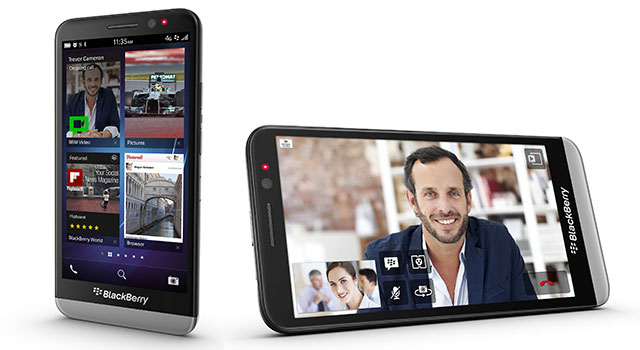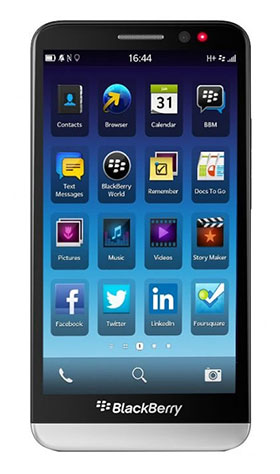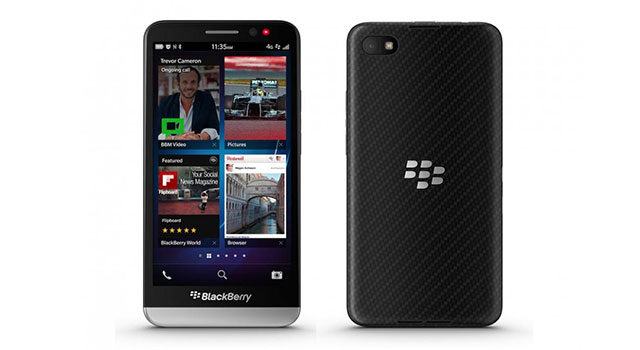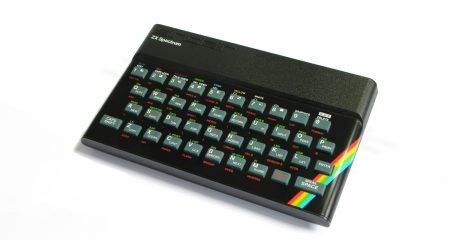
BlackBerry’s newest flagship smartphone, the Z30, is the successor to its very first BlackBerry 10-powered handset introduced earlier this year, the Z10. The most notable difference between the two is the Z30’s much larger 5-inch screen, up from the Z10’s 4,2 inches.
Like the Z10, it’s devoid of front-facing buttons, with rounded corners on the 5-inch display, and dimensions of 140,7mm x 72mm x 9,4mm compared to the 130mm x 65,6mm x 9mm of the Z10.
The Z30 is heavier at 170g, versus the 136g of its predecessor, but the added heft is quite manageable.
Surprisingly, the Z30 comes with a 1 280×720-pixel screen, for a pixel density of 295ppi — lower than the Z10’s 356ppi. But the Z30 has an Amoled display, which gives it more saturation and colours look better than on the Z10’s LCD, and viewing angles are good.
To the left of the handset are micro Sim and microSD card slots, but these can only be accessed by removing the backplate, which makes no sense as the battery is non-removable. It takes quite some effort to remove the backplate, too, something which could have been avoided by making the ports accessible from the side. Micro HDMI and micro USB ports sit below the Sim slot.
 To the right are the volume up and down keys, and between them is a media play/pause voice command button, which we kept pressing accidentally. Below that are noise-cancelling microphone ports. New to the Z30 are stereo speakers, on the lower-rear of the device, and another speaker and mic are higher up on the rear. BlackBerry refers to these speakers as BlackBerry Natural Sound, which provides an enhancement to voice and video chats within BlackBerry Messenger (BBM).
To the right are the volume up and down keys, and between them is a media play/pause voice command button, which we kept pressing accidentally. Below that are noise-cancelling microphone ports. New to the Z30 are stereo speakers, on the lower-rear of the device, and another speaker and mic are higher up on the rear. BlackBerry refers to these speakers as BlackBerry Natural Sound, which provides an enhancement to voice and video chats within BlackBerry Messenger (BBM).
The handset does feel ever so slightly heavy in the hand, but it has a more solid build to it and comes in the same carbon fibre lookalike back as the keyboard-based Q10. The front-facing camera now sits next to the speaker. The slightly-too-big BlackBerry logo still appears at the bottom of the screen.
Just like the Z10, there are no buttons on the face of the handset. This takes some getting used to, though a tutorial at start-up goes through the basics like swiping up and left to unlock the handset and access various services.
From the homescreen, swipe all the way to the left to get to the BlackBerry Hub, a unified inbox of e-mail, social media and other services, revamped for the new BlackBerry 10.2 update. A Priority Hub tab learns your habits over time and presents the most important messages from e-mail, social networks and other linked accounts.
The updated BB10 operating system also displays notifications from BBM in a preview format viewable from any app you’re in. You can choose to dismiss these or respond instantly without exiting the app you’re in.
The handset comes with a good selection of pre-installed apps such as Facebook, Twitter, Foursquare, LinkedIn, YouTube, Evernote, Box, Dropbox and Docs To Go. Once you are in an app and need to go back to the homescreen with the swipe-up gesture, it docks opened apps between the BlackBerry Hub and home screen icons.
Faster processor
The Z30 is powered by a 1,7GHz dual-core Snapdragon processor with quad-core graphics, a step up from the 1,5GHz dual-core one found in the Z10. It has the same 2GB of RAM and 16GB of storage as the Z10, with expandable storage.
The phone could handle running multiple apps without crashing. However, it struggled to play games, which froze the handset on launch on several occasions. The camera also stuttered a bit.
The main 8-megapixel camera, with 5x digital zoom, is decent, but with only basic options compared to other high-end handsets. Auto-focus didn’t work well and we ended up with a bunch of blurry pictures. The camera wasn’t snappy and there were a few seconds of lag between tapping the screen to capture an image before it rendered. It offers only four modes to shoot images – normal, stabilisation, burst and high dynamic range, with options to turn off the flash and change the ratio between square, standard and widescreen formats.

Unfortunately, cameras have never been BlackBerry’s strong point.
The phone records video at 1080p resolution, while the 2-megapixel front camera offers 3x digital zoom, fixed focus, image and video stabilisation and 720p recording.
The battery on the Z30 is a whopping 2 880mAh, a huge step up from the 1 800mAh battery on the Z10. It will easily last a full day.
Overall, the Z30 feels like an attempt that came too late. It’s a solid device with a big, bright screen, better battery life and faster processor. But its camera is disappointing and there’s a poor selection of apps and games, a problem that plagues all BB10-based handsets.
The BlackBerry Z30 is available from Vodacom at a recommended retail price of R8 799. It’s also available on contract. — (c) 2013 NewsCentral Media




